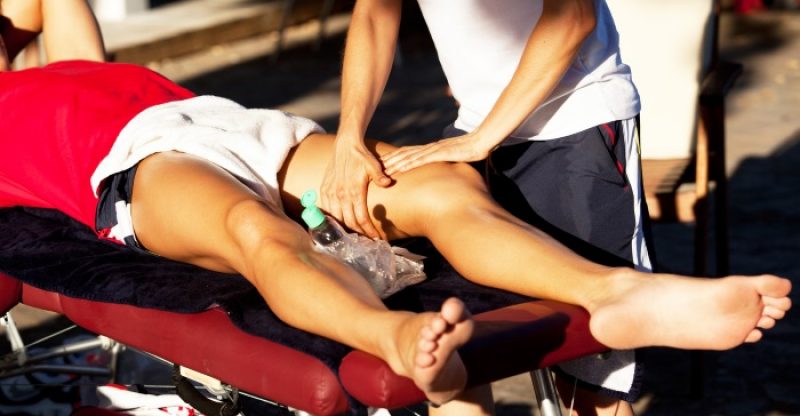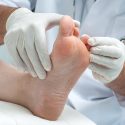9 Science-Backed Benefits of Sports Massage for Athletes and Non-Athletes
Most of us agree that massages are great: they’re enjoyable and relaxing, and being massaged correctly can make you feel amazing afterward.
Only a few of us understand the magic, however.
Where does the incredible feeling of well-being come from?
Let’s unravel some of the mysteries of massage (particularly of sports massage) here, and look at the science.
How does massage, and specifically sports massage, aid the human body?
What magic is happening beneath the skin?
Are the benefits only for athletes?
And are the effects only short-term, or can a sports massage have long-term benefits, too?
What’s So Great about Massage?
Well, lots of us are already familiar with the idea of massage for two particular purposes: either for general relaxation or to ease sore muscles.
While massage does fulfill these two aims, it accomplishes so much more; in actual fact, people who get a good massage gain more in a huge variety of ways.
It is these hidden benefits that keep people returning for a massage time and time again.
Massage, and most particularly sports massage, has far-ranging benefits that cover a range of physical, physiological and psychological needs of our bodies.
This applies to everyone, whether you are an athlete or not.
Sports massage can affect how much pain you feel. It can affect how you move.
It can affect how you think. It can affect how happy you feel.
And, everyone can benefit from a sports massage because everyone, athlete or not, would like to feel better, move better, be more positive and be happier.
What is a Sports Massage?
It’s important to understand the difference between general massage and sports massage when looking at the science.
This is because much of the science here only applies to sports massage (although there is also plenty of research looking at the positive effects of massage in general).
So, what is the difference?
Well, all massage involves manipulating the soft body tissues, i.e. the muscles, tendons, ligaments, joints and connective tissues, for a positive effect on our body.
This will usually involve techniques that involve rubbing or kneading sections of the body.
Most people get a massage for relaxation, others to ease aches and pains.
This is not a modern form of medicine.
Massage has been around for a long time as a form of physical therapy: the Greeks, Chinese and Indians were getting massages as far back as 3,000 years.
Sports massage comes under the umbrella of massage as a whole.
There are a lot of overlapping techniques that fall under both sports massage and more general massage therapy.
However, sports massage has some unique qualities.
Its differences tend to lie in the patient’s reason for seeking treatment, and the intended outcomes of the massage.
In other words, it is prescriptive and very much tailored to the individual’s needs and requirements.
Sports massage can be seen as a form of healthcare.
It is a clinical massage, designed mainly for treatment of musculoskeletal and soft-tissue injuries.
Those of us who regularly take part in sport may also use sports massage to help prevent problems that may interfere with this activity.
For these reasons, it is usually targeted at one specific area of the body.
But, that’s not the only difference.
The other key distinction is the level of expertise of the massage therapist.
A reputable therapist should have specific sports massage therapy training.
This will mean they have enough knowledge of biomechanics, anatomy, and physiology to successfully diagnose and treat a sports-related injury.
They should have advanced massage skills so that they can provide a specific, tailored treatment for each patient.
Plus, they should be able to advise their patient on how to ensure how healing can continue post-massage.
Alongside these, a qualified therapist will have further skills, perhaps in first aid and taping, gait analysis, massage for strengthening and conditioning muscles.
They may also have additional knowledge of nutrition and sports ethics.
What Techniques Might a Sports Massage Therapist Use?
You may have already experienced some of the techniques if you’ve had a massage for relaxation purposes; there is a lot of overlap.
A sports massage may comprise of the following targeted techniques:
Effleurage
This term comes from the French word for “skim.”
The technique involves a therapist sliding and smoothing their hands over the patient’s skin in a rhythmic, slow, and soothing manner.
Pressure will then gradually be built up.
It is a common way of beginning a massage, and it serves a few purposes: firstly, to warm tissues, increase blood flow and relax the patient; and to allow the therapist to palpate the areas that need to be treated to inform their treatment.
Petrissage
Again from a French term, petrissage means “to knead.”
It encompasses techniques which involve compressing then releasing soft tissues.
Pinching and releasing is one example of petrissage, or firm pressure another.
It could also involve picking up and shaking.
Its main aims are to increase the flow of lymph and other tissue fluids, stretch muscles, and remove waste from soft tissues.
Petrissage also seeks to increase mobility from tissue-to-tissue: seamless interactions between the different types of tissues are required for the body to be working at its best.
Frictions
“Frictions” is the technique of using the pads of the fingers and thumb to assert a large amount of pressure to a small area.
It is most useful for breaking down scar tissue, stimulating the healing process and restoring elasticity.
Tapotement/Percussion
This term describes the techniques which mainly involve trying to relax the muscles.
Examples are cupping, which involves using the hands to create an airtight cup shape that vibrates and vacuums the skin on impact, and striking the soft tissues in a hacking or chopping type motion with the hands.
These techniques are used by therapists to help prepare the patient’s body for exercise.
What does Science Tell Us about Sports Massage?
Sport is a huge industry worldwide.
That means there’s a whole lot of money being invested in its future.
Across the globe, groups of scientists are looking into how the performance of professional athletes can be further improved.
And this means that, over the last couple of decades, there have been lots of research into sports massage and its place in sports.
Some of this research has looked into the physiological benefits of sports massage to heal injury and get highly-paid athletes back on their feet more quickly.
Other research has looked into injury prevention benefits for sports people.
There’s also been research into whether sports massage can enhance performance and the psychological benefits, too.
But their findings don’t just apply to professional athletes.
Scientists at universities across the globe have found plenty of evidence that shows how a sports massage can benefit everyone, athletes or not.
Sports massage can improve your physical abilities in general, as well as have a positive effect on your mental health and general well-being.
Whether you like to dance, run, hike or swim in your spare time; have a physical job; commute by walking or cycling; have young children or pets to look after, sports massage can offer significant improvements to your ability to do these things.
Here are 9 ways that sports massage can benefit you:
Helps with Delayed Onset Muscle Soreness (DOMS)
Delayed onset muscle soreness (DOMS) is the name given to the delayed pain that we get after we try a new type of exercise, or if we exert ourselves more heavily than usual.
It usually appears 12-24 hours after the exercise, so it is common to wake up the next day after exercise and feel some pain or discomfort.
DOMS combines having limited movement and flexibility, the inability to use the muscle in the usual way, feeling very stiff and a localized pain.
This soreness peaks at around 48 hours but may take up to a week or so to fully disappear.
Although it is not completely clear what causes the discomfort of DOMS, it is thought that it could be a build-up of chemicals created by the body’s inflammatory response, or connective tissue damage.
Of the five full-length research articles produced to examine the relationship between massage and DOMS, all five are supportive of massage as a treatment.
One study by Rodenburg et al took 50 participants (27 of which were control, 23 of which received a 15-minute massage 15 minutes after treatment) found that soreness was lower at all time points with massage.
The massage had been conducted by a physiotherapist using the tapotement, effleurage, and petrissage techniques.
Not only did they find that soreness was reduced, but that a greater rate of force recovery was detected, too.
This means that normal strength was resumed quicker with massage than without.
This is great news for all of us.
If you are an athlete, DOMS can be a frustrating setback to your training schedule.
The knowledge that there’s something that can be done about it will be welcome.
For non-athletes, the thought of DOMS hitting the next day can put us off exercising strenuously.
DOMS aside, strenuous exercise can be good for our health, helping us lose excess weight, gain strength and improve our heart health.
If you’re thinking about starting up a new exercise regime but are worried about DOMS, putting a sports massage in the diary may help you keep your commitment to fitness.
Offers Everyday Pain Relief
Those of us who suffer from chronic pain know how uncomfortable everyday tasks can become.
Furthermore, if the pain is stopping you from exercising and getting out and about, you’ll be feeling frustration on top of all that pain.
For an athlete, pain is very bad news and can mean months out of training and competition while the cause of the pain is being treated.
The good news is that sports massage can provide pain relief in many cases.
In a study funded by the Australian Physiotherapy Association, researchers looked at whether massage could treat pain in the shoulders, knees, lower back and neck.
They found that, while massage couldn’t guarantee pain relief, “Massage therapy, as a stand-alone treatment, reduces pain … in some musculoskeletal conditions.”
Certainly worth trying if you’re struggling to reduce pain with other methods as it may make you comfortable enough to begin training again sooner, too.
Clears Lactic Acid from Muscles
When you work out strenuously, your bodies will struggle to get oxygen to your busy muscles fast.
Breathing hard is the body’s response to the muscles’ need for more oxygen.
The body generally prefers to produce its energy aerobically, i.e. through oxygen.
When it cannot efficiently do this, a process begins that produces lactic acid.
Scientific American explains the process behind lactic acid here:
“[When the body is then not able to provide energy through oxygen], the working muscles generate energy anaerobically. This energy comes from glucose through a process called glycolysis, in which glucose is broken down or metabolized into a substance called pyruvate through a series of steps. When the body has plenty of oxygen, pyruvate is shuttled to an aerobic pathway to be further broken down for more energy. But when oxygen is limited, the body temporarily converts pyruvate into a substance called lactate, which allows glucose breakdown — and thus energy production — to continue. The working muscle cells can continue this type of anaerobic energy production at high rates for one to three minutes, during which time lactate can accumulate to high levels.”
A byproduct of this process is the burning sensation that we can often feel when we have been particularly strenuous.
It is this feeling that stops us from working out further and forces us into recovery mode.
In Sports Massage: A Comprehensive Review, an argument is suggested that massage can “facilitate the clearance of lactate from tissue” because massage increases the flow of lymphatic fluid — the system which removes waste from cells back into the bloodstream.
This may mean quicker recovery after strenuous exercise.
Regular sports massage may help you keep your training schedule on track so you can hit those targets.
Aids in Recovery from Injury
Common sporting soft tissue injuries include ankle or hamstring strains, groin pulls and shin splints.
All these are caused by a sudden or unusual movement that asks soft tissue to stretch beyond its limits.
This is the reason why we can also call them “pulled muscles.”
The result of this pull or strain is a tear or deformation of the tissue, which can be painful and debilitating.
An ankle sprain, for example, is an injury to the ligaments, which are the soft tissues that connect the different bones within the ankle.
You could think of these ligaments as springs, which are designed to stretch and bend to allow a full range of movement at the ankle.
However, just like a spring, if we stretch them too far, they cannot return to their original shape, and their flexibility is compromised.
The same issue occurs with tendons, which attach muscle to bone (unlike ligaments which attach bone to bone).
Whether you are an athlete or not, you will probably suffer from this type of injury from time to time.
You may also injure yourself in this manner by tripping or slipping which then causes a part of the body to bend in an unusual way.
An injury like this can cost your weeks, maybe months, of training.
So, is there a way to recover more quickly?
A 1997 study of physical therapy on rats, where three minutes of pressure was applied to injured Achilles tendons, found that the treated animals recovered more quickly.
There has been surprisingly little research into the effects of massage on human injury, but the rat study certainly suggests that further research would be worthwhile and that there should be a tangible benefit to massage for treating a sporting injury.
Next time you twist an ankle or pull a muscle, try getting a sports massage rather than resting up on the sofa; it may get you up, about and back to normal a lot quicker.
Helps to Prevent Injury
A study by Weerapong et al at the New Zealand Institute of Sport and Recreation Research, suggests that massage may be able to help prevent injury through priming of the muscles before exercise:
“Massage can produce mechanical pressure, which is expected to increase muscle compliance resulting in increased range of joint motion, decreased passive stiffness and decreased active stiffness (biomechanical mechanisms).”
In other words, it may help overly tense muscles relax to become more flexible, or relaxed muscles to “wake-up” for exercise.
A muscle that is primed and warmed-up for exercise will be at its most flexible and, therefore, least likely to suffer injury.
Note that massage should not replace a traditional pre-exercise warm-up since that also helps to elevate core body temperature and blood circulation ready for exercise.
A massage can complement a good warm-up, however.
If you’re an athlete, you’ll be interested in avoiding injury and prolonging your career.
You’ll know how frustrating missing a key event or part of a season is.
Sports massage can be a good way of reducing the risk of unexpected injury.
Enhances Performance
One of the key things that drive athletes is ambition: to run their distance faster than ever before, to throw or jump further, to lift heavier weights, or to outperform the opposition more thoroughly.
This means athletes are constantly on the look-out for tweaks they can make to their training or competition preparation that will give them the edge.
These tweaks need to be ethical and within the regulations of their sport, of course.
It seems massage may be an effective, legitimate way of getting this edge.
Research from the North American Journal of Physical Therapy suggests that many elements of an athlete’s performance may be improved by massages, such as grip strength and vertical jumps for basketball players.
Gives Your Overall Health a Boost
A great side effect of a sports massage is that it may benefit your overall health, too.
Researchers believe they have found a link between post-exercise massage and some improvement to the immune system, the system which helps us ward off illness and disease.
Even minor common illnesses such as colds can mean missing training for athletes, so are a cause of frustration.
Just a few days out of competition can give a rival the edge.
A 2014 Spanish study led by Victor Tejero-Fernández reviewed previous research on sports massage and found that “High-quality but preliminary evidence supports the possibility that massage exerts immunological effects.”
Great news!
Helps Battle Against Depression
Massage doesn’t just benefit our soft tissues.
There are some brilliant psychological effects as well.
Scientists at the University of Miami studied a group of 37 breast cancer patients who had reported feelings of depression and anger.
A proportion of these patients were given massage therapy for 5 weeks, 3 sessions per week, for 30 minutes at a time.
The findings of the study, reported in The International Journal of Neuroscience, is good news: “the massage therapy group reported being less depressed and less angry and having more vigor.”
How does this happen?
The physical manipulation of the body can cause the release of feel-good chemicals, such as endorphins and serotonin, into the bloodstream.
These findings don’t just apply to breast cancer patients: there is no reason why massage can’t have a positive effect on everybody’s mental health, whether or not they are suffering from depression.
For athletes, a positive outlook is vital to have a competitive edge.
Massage may help you feel confident and positive about making your goals, meaning you’re more likely to get there!
Reduces Anxiety and Improve Sleep Quality
A similar study, also by researchers from The University of Miami working with breast cancer patients, had more great news.
Their findings, published in The Journal of Complementary Medicine, showed that a regular massage for three weeks can result in less anxiety.
Massage led to better sleep quality and a feeling of a greater satisfaction with one’s quality of life.
It is thought that massage can help with anxiety because it can help bring down high blood pressure and lower the heart rate.
These bring with them improved relaxation.
This news may help athletes: a pre-event massage to reduce anxiety may help an athlete stay focused and positive, resulting in a better performance.
A better-rested body will have more to give, too.
For non-athletes, anybody who suffers from anxiety or sleep deprivation knows how debilitating these can be.
Massage may be a pleasant and successful treatment plan.
Conclusion
Sports massage has such varied physical, physiological and psychological benefits that every athlete should consider making it a regular part of their routine.
Massage therapy can certainly complement good nutrition and the right training schedule to reach the next level of performance.
But there are plenty of advantages for non-athletes, too.
All these benefits can have an effect on your ability to get anything physically done and be able to enjoy it too: from walking the dog to gardening, to scaling a mountain.
FDA Compliance
The information on this website has not been evaluated by the Food & Drug Administration or any other medical body. We do not aim to diagnose, treat, cure or prevent any illness or disease. Information is shared for educational purposes only. You must consult your doctor before acting on any content on this website, especially if you are pregnant, nursing, taking medication, or have a medical condition.
HOW WOULD YOU RATE THIS ARTICLE?






